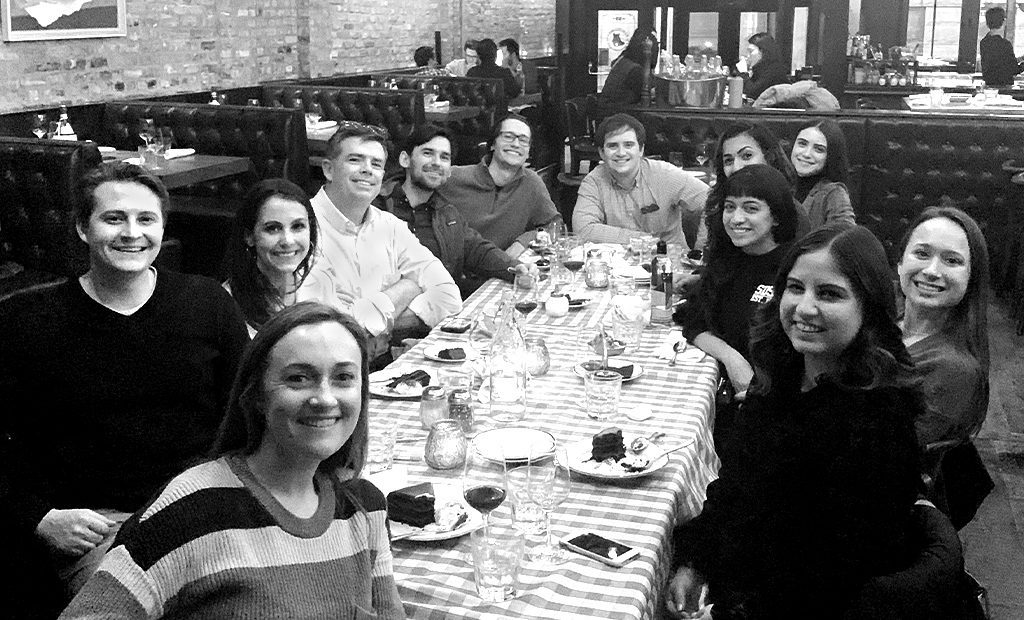For many, the new year starts in a similar fashion.
First, the holiday season lures us away from pressing work obligations and healthy eating habits (just me?). As we finally embrace that serenity, New Year’s Eve antics jolt us with a reminder that soon we must change out of our pajamas and get back to work. Good thing we love the work we do here at CG Life! (Seriously!)
Once we return to the office, the first week or two is relatively quiet…too quiet. By week three and four, things are popping off left and right. Soon, everyone is back up to speed, caffeine addictions are in full swing, and we’re firing on all cylinders and energized about the year ahead.
So, what exactly are we excited about? Rather than ask my colleagues about resolutions that often fall to the wayside, I polled our multi-disciplinary life science and healthcare marketing and communications team about what events, trends, shifts, and practices they were most excited to implement over the next 11 months. Below is a brief collection about what CG Lifers are paying attention to in 2020!
Digital Marketing Tactics and Public Perception in the 2020 US Election
 Jeremiah Worth
Jeremiah Worth
“Can I be excited and wary at the same time? If so, the spotlight cast by the upcoming presidential election on digital marketing tactics and platforms, the reasons behind their effectiveness and the moral quandaries that are presented when used to maximum efficiency is going to be red hot. It’s going to be fascinating to see how that focus influences public perceptions of their use and how that translates into changes for the digital marketing landscape, especially within paid media. From Facebook’s transparency behind its willingness to enable false advertising to campaigns openly sharing their tactics, the question for advertisers is going to be whether there is an advantage to finding a proper balance between integrity and impact, and the public’s role in drawing that line in the sand for them.”
- Jeremiah Worth , Vice President of Digital Marketing
Adobe XD Updates in Action to Improve Teamwork and Artistic Control
 Brookelyn Noelte
Brookelyn Noelte
“In the world of UX/UI design, the new updates to Adobe XD are very exciting for creating seamless interfaces in 2020. With the November additions of co-editing, hover states, component states, multiple interactions, and document history, Adobe allows designers to condense their number of artboards, work with a team, and have more control over their desired look and feel. Shareability got a whole lot easier too with the new and improved share mode. Overall, 2020 will continue to be an exciting year to create some amazing UX/UI designs!”
- Brookelyn Noelte , Junior Designer (Brookelyn was not paid for this review, she really is that excited!)
The Mad Dash to Prepare for Google Chrome Phasing Out Third-Party Cookies
 Matt Carter
Matt Carter
“Although not happening officially until 2022, Google recently announced that it intends to phase out third-party cookies from its internet browser, Chrome. This is a big change for our industry. In this coming year, advertisers will need to implement new strategies for data collection to keep pace with the $565 Billion global ad industry. Along these lines, we will need to learn about using Google’s new Privacy Sandbox tool, which is meant as the primary replacement for third-party cookies. This is an exciting and interesting shift that’s going to affect programmatic advertising for years to come.”
-Matt Carter , Digital Marketing Manager
Smarter, Better, Faster Digital Data Collection and Management
 Karen Sparks
Karen Sparks
“In the coming year, I look forward to our industry better unraveling the secrets of big data. Our industry continues to refine best practices for measuring, visualizing, and reporting digital information. This data tells us a lot about user behavior, helps inform improvements to user experience, and offers measurable windows into marketing success. However, with a wide range of data collected from vast numbers of individuals, curation and visualization of the available information becomes all the more critical to reveal the insights buried beneath the data. Often, the question becomes, ‘what numbers are truly important to look at to measure a specific campaign’s success?’ Just like big data management in technologies like next-generation sequencing, marketers can struggle with similar challenges around how to accurately make use of all the data.”
-Karen Sparks, Vice President of Client Strategy
The Beginning of the End for Click-Through Paid Search Ads?
 Colin Sanchez
Colin Sanchez
“Google will beta-test lead extension in 2020, which is a new way to capture leads without driving users to a landing page. In this beta version, users can respond to calls-to-action or request more information directly from Google Search ads. This ad strategy might end up being a good option to capture leads from search engine results pages, bypassing the need for new landing page development. At the same time, it may not make sense for every campaign since the scientific/healthcare sales cycle is typically longer, and the products are much more expensive. As a result, people are less likely to drop their lead info right then and there. Either way, Google appears to be actively thinking about how to quickly and effectively drive lead generation.”
-Colin Sanchez , Digital Marketing Specialist
Seeing Digital Information Bear Fruit for Both Marketing and Healthcare
 Erik Clausen
Erik Clausen
“Smarter information capture and artificial intelligence have long been changing human society, but some fields have been slower to integrate with the advancing digital landscape. Two of CG Life’s fields, marketing and healthcare, have recently come to fully embrace digital information, but the scale of the payout continues to grow.
For one, I’m looking forward to seeing how enhanced marketing automation capabilities can deliver quality targeted information to the right folks without blasting entire user lists. This will increase engagement and reduce collective fatigue. To this end, CG Life recently acquired TheMarketElement, a Colorado-based digital marketing agency, to vastly expand our own marketing automation capabilities. In addition, I’ll be waiting for more integration between digital health and pharma. Both industrial and governmental bodies have warmed up to the incorporation of both digital health monitoring and machine learning drug discovery and development into how we treat disease. It’s going to be fun watching this come together!”
-Erik Clausen, Managing Partner
The Growing Role and ROI of Paid Social Media Advertisement
“The paid media department is excited to further expand our paid social capabilities in 2020 by launching newer and more sophisticated client campaigns on LinkedIn, Facebook, and Twitter. With each passing year, social media platforms include more ad formats and targeting strategies that we can implement to selectively target the right audience.
 Jordan Nelson
Jordan Nelson Menaka Ramprasad
Menaka Ramprasad Natalie Rodriguez
Natalie Rodriguez
The key here is to make sure we deliver high-quality information that solves consumer problems and fits needs. To achieve this, we are able to target individuals based on what they include on their LinkedIn or Facebook profiles as skills, interests, behaviors, or groups. We create audiences that match our preferred target market and serve ads only to our desired audience. Collectively, this helps us reach individuals beyond subscription lists to cast a wider net, flexibly targeting users by behavior/interests, generating more leads, and increasing brand recall. What’s not to like? We’re eager to see what the social media giants will add in this coming year, while we continue to run successful 2020 campaigns that increase our client’s social advertising campaign reach.”
-Jordan Nelson, Menaka Ramprasad, Natalie Rodriguez , Paid Advertising Campaign Managers
Cultivating Productive Dialogue and Relationships Through “Reading & Reacting”
 Ben Marcus, Ph.D.
Ben Marcus, Ph.D.
“I love Star Wars. I also appreciate smart and effective science writing. So, when I read the story ‘Let’s Use Star Wars to Explain the Concept of Angular Size’ in WIRED, I was very impressed with how the author, Rhett Allain, cleverly used a popular piece of American culture to disguise a math lesson. I tweeted out my jealousy of his science writing skills, and Rhett responded with words of encouragement. I was very excited to get a real, human response from a WIRED reporter I’ve never talked to before.
In this age of incredible political divisiveness, #fakenews, and “woke” culture, journalists rarely receive positive feedback on their work from their readers. People are much more likely to yell at reporters about something they disagree with than praise reporters whose work they enjoy – and those who wish to voice their anger have greater access to journalists than ever before, especially through their Twitter handles and through the comment sections under their articles.
But I think these channels through which people can react to journalists can be used for good. In fact, because negative comments are so common, positive feedback sticks out. By honestly praising journalists on their work through emails, tweets, and comments on their websites, I’ve received thanks from many individuals who appreciate positive feedback, and I’ve been able to develop relationships in cases where a typical email or phone pitch wouldn’t get through. As we move through 2020, I think public relations will involve reaching out to journalists in new ways and demonstrating that we truly appreciate and understand their work. By building those relationships, public relations professionals will demonstrate that they understand the journalist community and that they have valuable stories to tell.”
-Ben Marcus , Public Relations Account Supervisor
As a final aside, I also want to briefly mention that Chemical & Engineering News recently published their World Chemical Outlook 2020. I encourage readers to go check out what the C&EN team believes will be important issues in the Chemical and Pharmaceutical industry. The article covers a lot of interesting ground ranging from science, market trends, and policy outlook.
What are trends are you paying attention to for this year? We want to hear it. Tweet @ us with your thoughts!
